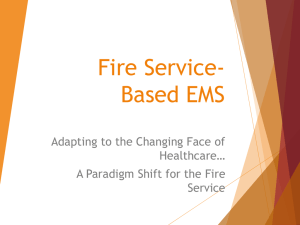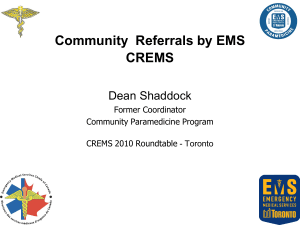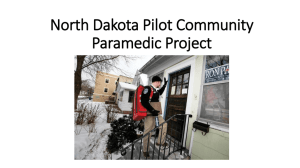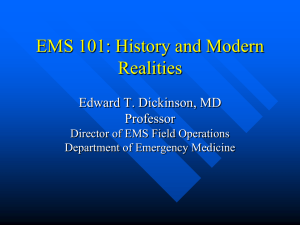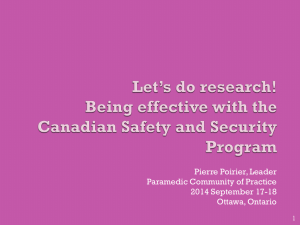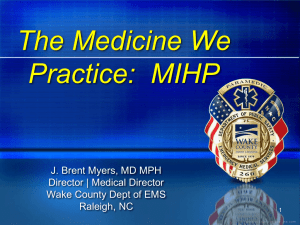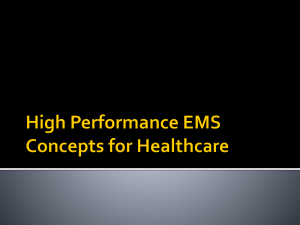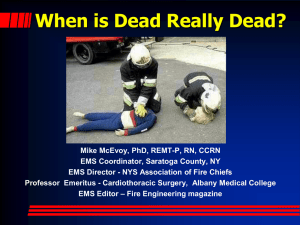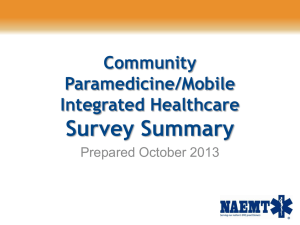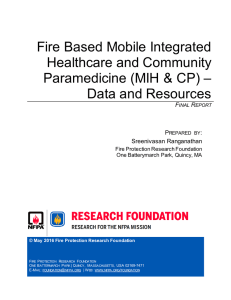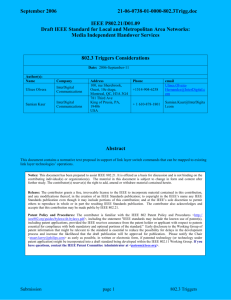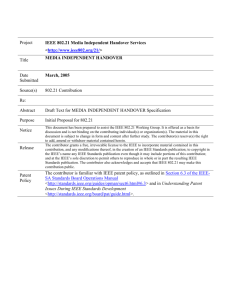MIH NCAEMSA 4-17 Abridged - North Carolina Association of
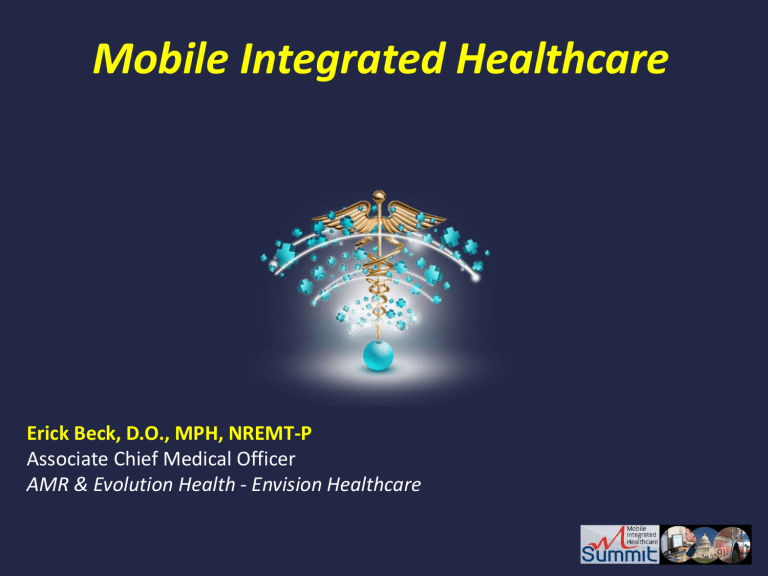
Mobile Integrated Healthcare
Erick Beck, D.O., MPH, NREMT-P
Associate Chief Medical Officer
AMR & Evolution Health - Envision Healthcare
Session Goals
• Update on Current MIH Programs in the U.S.
• Results of NAEMT/JNEMSF MIH-CP Survey
“Mobile Integrated Healthcare is an innovative and patient-centered approach to meeting the needs of
patients and their families. The model does require you to “flip” your thinking about almost everything – from roles for health care providers, to what an EMT or paramedic might do to care for a patient in their home, to how we will get paid for care in the future.
The authors teach us how to flip our thinking about using home visits to assess safety and health. They encourage us to segment patients and design new ways to relate to and support these patients. And they urge us to use all of the assets in a community to get to better care.
This is our shared professional challenge, and it will take new models, new relationships, and new skills. “
Maureen Bisognano
President and CEO
Institute for Healthcare Improvement
MIH-CP Program Updates
Dallas Fire-Rescue to offer home health care checkups
By TRISTAN HALLMAN
18 November 2013
Most doctors don’t make house calls anymore. But some Dallas-Fire Rescue paramedics soon will. A pilot program starting next year calls for paramedics to visit the homes of frequent 911 callers.
The idea behind the Mobile Community Healthcare Program is to try to prevent and reduce health emergencies, officials said Monday at a Dallas City Council public safety committee hearing.
Assistant Fire Chief Norman Seals, who oversees the EMS bureau, told members of the
City Council’s Public Safety Committee that he was “really fired up” about the program. He said he hopes to expand it as he restructures some EMS services.
The plan drew praise from committee members.
“This is a fantastic program,” council member Sandy Greyson said. “This is what we’ve been needing for a long time. This is the way to go. … This is really the future.”
Firefighter, nurse practitioner team up for 'urgent care on wheels'
Jan 23, 2013 - MESA, Ariz. - The Mesa Fire Department is getting some national attention for a program that started back in August. It's an idea that may be helping with overcrowded emergency rooms.
For the past six months, a Mesa Fire Captain has been teamed up with a nurse practitioner to respond to low-level emergencies.
Mesa Fire/Medical teamed up with Mountain Vista Hospital, pairing up
Fire Captain Brent Burgett and nurse practitioner Tom Morris to respond to low-level emergencies.
Green Bay Hospital Enlists
Fire Department To Visit
Patients At Home
April 29, 2013
Bellin Health, a major healthcare provider in northeastern Wisconsin, is teaming up with the Green Bay fire department to check up on patients.
Bellin Hospital is paying the city $50 each time firefighters are dispatched at Bellin’s request to make house calls on discharged patients.
As a bonus, she says, firefighters found a problem with a smoke detector in one patient’s house.
Ontario Expanding Community Role for Paramedics
Community Paramedicine Programs Improving Access to Care for
Seniors
January 21, 2014
“Ontario is supporting the expansion of community paramedicine programs to improve access to home care and community support services for seniors and other patients with chronic conditions.
The province is investing $6 million to support the expansion and development of community paramedicine initiatives across the province. These programs allow paramedics to apply their training and skills beyond the traditional role of emergency response…”
“Community Paramedicine programs help patients get the care they need in their communities, while reducing unnecessary emergency room visits and hospital admissions .
These new supports for community paramedicine will also help seniors and patients with chronic conditions manage their conditions better and stay healthy.
”
Deb Matthews
Minister of Health and Long-Term Care
Wake County, NC
(Wake County EMS)
• Program Goals & Methods:
– Respond
• High acuity, low frequency calls
• High-risk AMA’s (2 0 resource and ? Follow-up)
– Reduce
• Low acuity, high frequency calls
• SNF falls
– Redirect
• Substance Abuse / Mental Health
• Funding:
– Self funded
Wake County, NC
(Wake County EMS)
• Outcomes - 2013
– Respond:
• Overall SCA survival of 14%
• 90% neurologically intact
• Shockable rhythms = 38%
– With a 98% neurologically intact survival rate
– Reduce:
• Evaluated over 150 patients
• No adverse outcomes
– Redirect:
• 1,503 patient encounters, 514 (34.2%) met diversion eligibility criteria
• 315 (61.2%)agreed to be transported to WakeBrook instead of the local ED
• Only 4 (1.3%) patients transported to WakeBrook were referred back to the ED, none of whom subsequently required medical intervention
• 199/315 patients (63.2%; CI95 57.8-68.3) treated and discharged home with mental health follow-up
• Estimate program saving = 2,448 ED bed hours
• 100 hospitalizations
• Reduced costs of care by $500K
Allegheny County, PA
(Center for Emergency Medicine)
• Program Goals & Methods:
– Improve patient outcomes and experience of care
– Reduce preventable ED visits and hospitalizations
• Primary focus - familiar faces and vulnerable patients
– Regional service delivery model
• Referrals from 45 EMS agencies and 15 hospitals in
Allegheny County (Pittsburgh and surrounding communities)
– Psycho-social assessment by Community Paramedic
• Serves as patient navigator, patient advocate and health coach to get patient enrolled in applicable social service agencies
Allegheny County, PA
(Center for Emergency Medicine)
• Outcomes:
– Over 250 patients referred to program since launch in
September, 2013
– One patient with 29 EMS trips to ED prior to our involvement for uncontrolled hypoglycemia
• Since enrollment, back 1 time for a problem with his fistula.
Estimated savings of $21,000 in avoided EMS trips and ED costs
• Funding
– Two year, $500,000 grant funded by (very) competitive integrated delivery systems
Hunt County, TX
(American Medical Response)
• Program Goals & Methods
– Frequent system utilization
• Funding
– Grant funded
• Outcomes
– Scheduled visits for familiar faces
– Telephonic intervention coupled with in-home visits
– Average 88.9% reduction in EMS transports
– Average 69.2% reduction in emergency department utilization
– Average 45.4% reduction in hospital admissions
Eagle County, CO
(Eagle County Paramedics)
• Program Goals & Methods:
– Ensure all patients have a medical home
– Reduce re-hospitalizations by 50%
– Enhance injury prevention versus potential costs associated with no prevention
– Enhance number of vaccinations given and Public
Health visits
• Funding:
– Self funded
Eagle County, CO
(Eagle County Paramedics)
• Program Goals & Methods:
– Single Community Paramedic deployed into rural community
– Post discharge follow-up
– Primary care follow-up
– School Based Health
– Injury Prevention – Community
– Public Health
– Social Services Adult Protection visits
– In home lab services
– Starting new Mental Health and Substance abuse program with County and Hospital
Eagle County, CO
(Eagle County Paramedics)
• Outcomes:
– CP Team was part of hospital team that reduced readmissions in our local hospital last year over
75%
– N=1100 patients that fit criteria Initial Readmit rate was 4.26% decreased to 1.01%
– Health Care Expenditure Savings per patient visit
$1,279
St. Louis, MO
(Barnes-Jewish / Abbott EMS / AMR)
• Program Goals & Methods
– Targeted readmission reduction
• Funding
– Hospital contract
• Outcomes
– Reduction of CHF, AMI, COPD and pneumonia admissions
– 10 patients to date
Minneapolis, MN
(North Memorial Medical Center)
• Program Goals & Methods:
– 16 CP's in 3 Primary Clinics in the North Minneapolis area
• 12-14 patients per 12 hour shift
• Assigned patients by a clinic coordinator
• Primary Care focused
• Patients need to have a care plan or be in a medical home
• Medical home and care plan avoids duplication of service
• Focus on patients with chronic disease with a heavy emphasis on Diabetics
• Assistance with wound management
• All lab work completed on-site
• Tracks frequent ER utilization with follow-up
Minneapolis, MN
(North Memorial Medical Center)
• Outcomes:
– Outcomes continue to be tracked unofficially, with outcomes subjectively, felt to be very positive.
• Work at the state level to develop a common data base to show the positive results of using a CP
• Data should be available soon
• Current Health Care Delivery system medical assistance demo project with 6,000 enrollees has shown an over all reduction in per member per month cost of medical assistance patients
• With the reduction gets a shared saving payment to the healthcare system from managed care and state fee for service
Minneapolis, MN
(North Memorial Medical Center)
• Program Funding:
– CP’s integrated in a Medicare shared savings ACO program with 10,000 enrollee’s
– CP’s primarily target the MA population in a state
Health Care Delivery System demo (HSDS) with
6,000 enrollee’s
– Medical assistance covers eligible CP services at the rate of $60 an hour of the patient is in a primary care plan or assigned to a medical home
Arlington, TX
(American Medical Response)
• Program Goals & Methods
– Frequent system utilization and readmission reduction
• Funding
– Hospital and City share FTE cost
• Outcomes
– Targeting CHF, COPD and cardiac patients
– 165 patient census
– Average 88.9% reduction in EMS transports
– Average 69.2% reduction in emergency department utilization
– Average 45.4% reduction in hospital admissions
St. Louis, MO
(Christian Hospital EMS)
• Program Goals & Methods:
– Increase Population Health
– Improve patient outcomes and experience of care
– Navigate non-medical emergency patients from using EMS and ED
– Reduce EMS and ER abuse for non-medical emergencies
– Decrease financial loss in ER and EMS for non-medical emergencies
– Ambulance and an specially trained paramedic responds to low-acuity calls
– Patients are triage and receive a medical screen
• If no medical emergency exists we will not transport to the hospital.
We will treat at home, make an appointment to the Health Resource center or set up appointment with their PCP
St. Louis, MO
(Christian Hospital EMS)
• Outcomes
– Navigated 1100 non-medical emergency patients away from the ER40 high utilizers from EMS and the
ER
– Decreased EMS and ER volume 11% respectively
– 22% decrease in EMS and ER use with this group since the 10th of February
• Program Funding
– Awarded $100,000 grant from the hospital foundation, contracts pending with private payers and
ACO
Reno, NV
(REMSA)
• Program Goals & Methods:
– Improve access to appropriate levels of quality care and treatment by 40%
– Reduce total patient cost by $10.5 million over three years for Washoe County 911 acute and non-acute patients.
• 9-1-1 emergency ambulance triage and treatment redesign:
Alternative pathways are provided to patients seeking medical evaluation of urgent medical conditions.
• Stakeholder and community engagement: New linkages between the emergency ambulance delivery system and the broader health care delivery system.
• Aligned financial incentives: Reform of existing payment systems achieves sustainable funding of patient care services.
Reno, NV
(REMSA)
• Program Funding
– $9.5 million CMMI grant
– New contract with hospital system for Nurse
Advice line
Las Vegas, NV
(American Medical Response)
• Program Goals & Methods
– Frequent system utilization
• Funding
– Self funded
• Outcomes
– Scheduled visits for familiar faces
– Medic accompanies patient to PCP appointments
– Average 88.9% reduction in EMS transports
– Average 69.2% reduction in emergency department utilization
– Average 45.4% reduction in hospital admissions
Chicago, IL
(MedEx & University of Chicago)
• Program Goals & Methods
– Readmissions reduction
• Funding
– Hospital and home health funded pilot
• Outcomes
– Paramedic transitional care visit in 0-24 hours
– HRS Home health partnership for ongoing home care
– 35 transitional care patients
– Enhanced patient experience
– Average 89% reduction in hospital admissions for enrolled patients
Fort Worth, TX
(MedStar Mobile Healthcare)
• Program Goals:
– Reduce preventable 9-1-1 and ED use in High
Utilizer Group (HUG) patients
– Redirect low-acuity 9-1-1 callers to better care setting
– Reduce preventable 30-day CHF readmissions
Reduce preventable observation admissions
– Reduce Voluntary Hospice Disenrollment
– Reduce ED visits for Home Health patients
Fort Worth, TX
(MedStar Mobile Healthcare)
• Methods:
– MHPs proactively manage patients through education, connection with patient centered medical homes and 9-1-1 redirection when appropriate
• Including in-home diuresis if necessary
– RNs use internationally developed and local medical control approved nurse advice algorithms to help the patient access the most appropriate care setting for their medical needs
– MHPs receive Obs patients and provide in-home assessments to avoid
Obs Admit
– MHPs respond to registered hospice patients to evaluate and navigate with assistance of hospice RN
– Home Health patients registered in CAD, MHP response & assess, coordinate with Home Health RN
• And do night/weekend call for agency
Fort Worth, TX
(MedStar Mobile Healthcare)
• Outcomes:
– HUG - 74 patients with 2-years of data (340 total)- averaging 54% reduction in
9-1-1 or ED use in enrolled patients during enrollment, 83% reduction postgraduation. Patient satisfaction 4.9 out of 5 (5 being most satisfied).
– 9-1-1 Nurse Triage - 1,382 9-1-1 callers referred to RN, 566 (41%) referred to alternate disposition. Patient satisfaction 4.6 out of 5 (5 being most satisfied) and 93% stated talking with the nurse helped.
– CHF Readmission - 23 patients enrolled that had a prior 30-day readmit AND the primary care coordinators believed a readmission was likely. Only 3 patients (13%) had a 30-day readmission. Patient satisfaction 4.9 out of 5 (5 being most satisfied). EuroQol Self-Assessment of Health Status improvement of 38%
– Obs Admit Prevention - 73 patients enrolled. Only 3 patients (4%) had a revisit to the ED prior to PCP appointment.
– Hospice Revocation Prevention - 114 patients at-risk for revocation enrolled, only 12 (11%) revoked.
Fort Worth, TX
(MedStar Mobile Healthcare)
• Program Funding
– Patient enrollment fee from referring agencies; or
– Patient contact fees from referring agencies
– Direct funding from hospitals for 9-1-1 Nurse
Triage
– Per enrolled patient/per month for Hospice program
NAEMT/JNEMSLF Survey
• To better understand the extent and characteristics of MIH/CP programs across the country
• To have a basis for understanding the MIH/CP trend
– which helps all of us in EMS – so we can develop strategies and policies to support it
• Distribution assistance from the JNEMSLF
NAEMT MIH/CP Committee
Representation from…
Survey results at-a-glance
• 3,781 total responses were received
– Total responses were evenly dispersed across all types of EMS delivery models.
• 232 unique MIH/CP programs were reported
– (6% of responses).
• 566 respondents (15%) indicated that their
EMS agencies were in the process of developing a MIH/CP program.
Catalyst for starting a MIH/CP program
Gap analysis of health needs
68%
Community assessment
Other CP programs
30%
Other healthcare stakeholders
20%
Other
7%
Combat repeat users
1%
66%
Respondents were able to select more than one response, resulting in a percentage total greater than 100%.
Participants in initial MIH/CP program assessment
Medical Director 77%
Hospital
Other EMS services
44%
Public health
41%
Home health
21%
Other
7%
77%
Time MIH/CP program has been in operation
Less than 1 year: 42%
1 – 3 years: 23%
More than 3 years: 35%
MIH/CP program models
Frequent EMS User
66%
Readmission avoidance
46%
Primary care/physician extender model
See and refer to alternate destination after assessment
28%
24%
911 Nurse Triage
8%
Who participates in providing patient care?
Paramedics
EMTs
AEMTs 25%
Nurses 24%
Physicians 21%
Nurse Practitioners 12%
Physician Assistants 12%
54%
94%
MIH/CP practitioners
• Are practitioners paid a higher rate than traditional roles?
YES : 37% NO : 63%
• Do practitioners have an advanced scope of practice?
YES : 11% NO : 89%
Next Steps
• Conduct follow-up survey of MIH/CP programs
– Drill down a little further to round out info
• Publish results
– Communicate to Stakeholder groups
• MIH/CP Vision Statement
– Endorsed by committee member agency representatives, plus…
Opportunities in Your Community?
Thank you for this Privilege!
For a copy of this presentation, or general questions, scan the QR code
